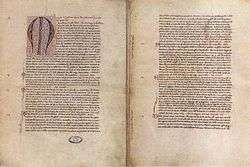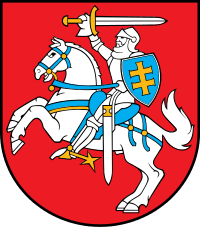Kingdom of Lithuania
| Kingdom of Lithuania | ||||||||||||
| Lietuvos Karalystė | ||||||||||||
| ||||||||||||
Green - Lithuania in 1251; Dark Green - territory annexed by 1263 | ||||||||||||
| Capital | Kernavė | |||||||||||
| Languages | Lithuanian, Ruthenian | |||||||||||
| Religion | Catholicism (institutional), Baltic paganism (widely practiced), Eastern Orthodox Church (in Slavic lands) | |||||||||||
| Government | Monarchy | |||||||||||
| King | Mindaugas I | |||||||||||
| History | ||||||||||||
| • | Status of kingdom received | July 17, 1251 | ||||||||||
| • | Coronation of Mindaugas | July 6, 1253 | ||||||||||
| • | Mindaugas assassinated | 1263 | ||||||||||
| ||||||||||||
The Kingdom of Lithuania was a Lithuanian monarchy which existed from 1251 to roughly 1263.[1] King Mindaugas was the first and only crowned king of Lithuania. The status of a kingdom was lost after Mindaugas' assassination in 1263. Other monarchs of Lithuania are referred to as Grand Dukes, even though their status was almost identical to that of a king. Two attempts were made to reestablish the Kingdom – by Vytautas the Great in 1430 and by the Council of Lithuania in 1918.
King Mindaugas

In the early 13th century, Lithuania was inhabited by various pagan Baltic tribes, which began to organize themselves into a state – the Grand Duchy of Lithuania. By the 1230s, Mindaugas emerged as the leader of the Grand Duchy. In 1249, an internal war erupted between Mindaugas and his nephews Tautvilas and Edivydas. As each side searched for foreign allies, Mindaugas succeeded in convincing the Livonian Order not only to provide military assistance, but also to secure for him the royal crown of Lithuania in exchange for his conversion to Catholicism and some lands in western Lithuania. The status of a kingdom was granted on July 17, 1251, when the Bishop of Chełmno was ordered to crown Mindaugas by Pope Innocent IV.[1] Two years later, Mindaugas and his wife Morta were crowned as the King and Queen of Lithuania.[1] In 1255, Mindaugas received permission from Pope Alexander IV to crown his son as King of Lithuania.
The coronation and the alliance with the Livonian Order allowed a period of peace between Lithuania and Livonia. During that time the Lithuanians expanded east, while Livonia attempted to conquer Samogitia. Enticed by his nephew Treniota, Mindaugas broke the peace after the Order was defeated in the Battle of Skuodas in 1259 and Battle of Durbe in 1260. Treniota's influence grew as he waged a war against the Order and his priorities began to diverge from those of Mindaugas.[2] The conflict resulted in assassination of Mindaugas and two of his sons in 1263. The country reverted to paganism and its status as a kingdom was lost. The state survived as the Grand Duchy of Lithuania and the subsequent monarchs are known as Grand Dukes as they could not be crowned as kings until they converted to Christianity (the Christianization of Lithuania occurred only in 1387).
Attempts to reestablish the kingdom
There was an attempt by Grand Duke Vytautas the Great (ruled 1392–1430) to receive the royal crown. As discussed at the Congress of Lutsk, he was proclaimed king, and Lithuania a kingdom, by Sigismund, Holy Roman Emperor, in 1430, but the royal crown, which was sent by Sigismund to Vytautas, was intercepted by Polish noblemen.[3] Soon afterwards Vytautas died, without being crowned as king.
After Lithuania declared independence in February 1918, the monarchy was reestablished and the 2nd Duke of Urach was invited to become King Mindaugas II. However, the monarchy was short-lived and Mindaugas II never visited Lithuania.[4] The Kingdom of Lithuania was a client-state of the German Empire and following Germany's defeat in World War I in fall 1918, the idea of a monarchy was abandoned in favor of a democratic republic.
See also
References
- 1 2 3 Gudavičius, Edvardas (1998). Mindaugas (in Lithuanian). Vilnius: Žara. ISBN 9986-34-020-9.
- ↑ Kiaupa, Zigmantas (2002). "Mindaugo karalystės raida". Gimtoji istorija. Nuo 7 iki 12 klasės (in Lithuanian). Vilnius: Elektroninės leidybos namai. ISBN 9986-9216-9-4.
- ↑ Stone, Daniel (2001). The Polish–Lithuanian State, 1386–1795. A History of East Central Europe. University of Washington Press. p. 11. ISBN 0-295-98093-1.
- ↑ Page, Stanley W. (1959). The Formation of the Baltic States. Harvard University Press. p. 94. OCLC 100463.



